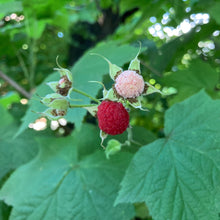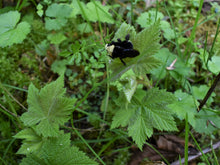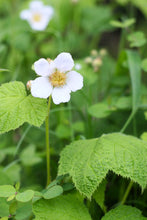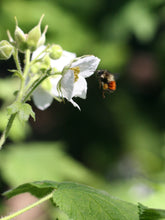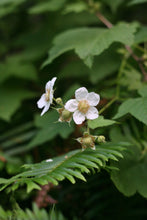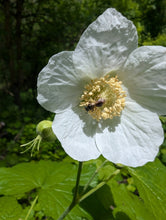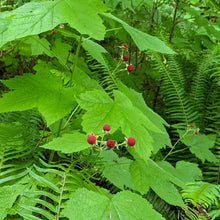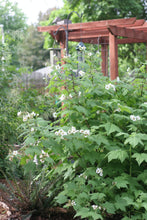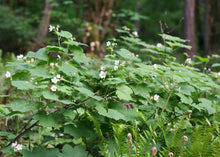
Rubus parviflorus
Thimbleberry is a fuss-free, thicket-forming deciduous shrub, with maximum habitat value and edible fruits. Each spring, maple-like velvety leaves emerge followed by bright, cheerful white flowers that delight butterflies and bees. By summer, lookout for vibrant, thimble-shaped red fruits that are a prized food source for countless birds and mammals, including humans!
- Plant type/canopy layer: deciduous, large shrub
- Size at maturity: 4-6' tall, 3-6' wide
- Light requirements: full sun, part sun/part shade, full shade
- Moisture requirements: dry to moist soil
- Bloom time: May - June
- Growth rate/ease: fast-growing, easy to grow
- Wildlife support: overall this plant is one of the best summer foods for wildlife and a caterpillar host plant; bear, beaver and marmots eat all plant parts; berries are popular with countless birds including jays, robins, thrushes, towhees, grouse, pigeons, quail, grosbeaks, sparrows, waxwings, and more, as well as raccoons, opossums, foxes, squirrels, and chipmunks; leaves are eaten extensively by deer and rabbits, used by leafcutter bees for nest building, and are a larval food source for native butterflies and moths; flowers attract and provide nectar and pollen to hummingbirds, adult butterflies, bees, and other insect pollinators and support beneficial and other pest eating insects
- Native habitat/range: common in moist to dry open woods, fields and along shorelines and forest edges, from sea level to 2500m, in many parts of western and northern North America; from southeastern Alaska eastward throughout the Rocky Mountain states to the Great Lakes region, and south to northern Mexico. Portland Plant List - yes.
- Special features & uses: beneficial insect, pollinator and wildlife magnet, including hummingbird favorite; landscape uses include pollinator gardens and woodland gardens, erosion control and hedgerows; young early spring shoots, late spring flowers and summer berries are all edible, though the flavor of the berries varies from sweet to bland depending on the growing conditions, making berries into jelly is another option; the large leaves can be handy containers for collecting berries, for wrapping and preserving other foods and as "nature's toilet paper; the bark was can be boiled into soap; medicinally, the dried leaves can be made into a powder and applied to wounds and burns to prevent scarring and a tea can be made of the leaves and/or roots to treat nausea, vomiting, diarrhea and dysentery and are rich in vitamin C, helping to boost the immune system and ward off scurvy
Gardening with Thimbleberry: This thicket-forming shrub needs virtually no special care, beyond space and a little tolerance on behalf of the gardener. It will thrive in moist or dry soil, from full sun to full shade. Its oversized, soft textured leaves make a bold contrast in the garden and turn a bright, golden yellow in fall. It is especially attractive on hillsides with dappled shade, where they will help control erosion. Be sure to give it lots of elbow room, as it wants to form a large, bramble overtime. Sacrifice part of your yard to this plant and you’ll be generously rewarded by its abundant floppy white blooms, massive insect and wildlife benefits, and edible berries.
Photo Credits 1 (berries closeup): Tracy Cozine, Sparrowhawk Native Plants
Photo Credit 2 (bumblebee on leaf): Nikkie West, Sparrowhawk Native Plants
Photo Credit 3, 4, 5, 8, 9 (flower closeups, thicket in the garden/wild): Karli Del Biondo, Beetles and Bees
Photo Credit 6 (flower with insect): © Steve Leavitt, some rights reserved (CC-BY-NC)
Photo Credit 7 (with berries): © John A Haskins, some rights reserved (CC-BY)









